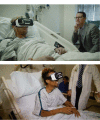Virtual Reality for Management of Pain in Hospitalized Patients: Results of a Controlled Trial
- PMID: 28356241
- PMCID: PMC5390112
- DOI: 10.2196/mental.7387
Virtual Reality for Management of Pain in Hospitalized Patients: Results of a Controlled Trial
Abstract
Background: Improvements in software and design and reduction in cost have made virtual reality (VR) a practical tool for immersive, three-dimensional (3D), multisensory experiences that distract patients from painful stimuli.
Objective: The objective of the study was to measure the impact of a onetime 3D VR intervention versus a two-dimensional (2D) distraction video for pain in hospitalized patients.
Methods: We conducted a comparative cohort study in a large, urban teaching hospital in medical inpatients with an average pain score of ≥3/10 from any cause. Patients with nausea, vomiting, dementia, motion sickness, stroke, seizure, and epilepsy and those placed in isolation were excluded. Patients in the intervention cohort viewed a 3D VR experience designed to reduce pain using the Samsung Gear Oculus VR headset; control patients viewed a high-definition, 2D nature video on a 14-inch bedside screen. Pre- and postintervention pain scores were recorded. Difference-in-difference scores and the proportion achieving a half standard deviation pain response were compared between groups.
Results: There were 50 subjects per cohort (N=100). The mean pain reduction in the VR cohort was greater than in controls (-1.3 vs -0.6 points, respectively; P=.008). A total of 35 (65%) patients in the VR cohort achieved a pain response versus 40% of controls (P=.01; number needed to treat=4). No adverse events were reported from VR.
Conclusions: Use of VR in hospitalized patients significantly reduces pain versus a control distraction condition. These results indicate that VR is an effective and safe adjunctive therapy for pain management in the acute inpatient setting; future randomized trials should confirm benefit with different visualizations and exposure periods.
Trial registration: Clinicaltrials.gov NCT02456987; https://clinicaltrials.gov/ct2/show/NCT02456987 (Archived by WebCite at http://www.webcitation.org/6pJ1P644S).
Keywords: hospitalization; inpatients; pain; virtual reality.
©Vartan C Tashjian, Sasan Mosadeghi, Amber R Howard, Mayra Lopez, Taylor Dupuy, Mark Reid, Bibiana Martinez, Shahzad Ahmed, Francis Dailey, Karen Robbins, Bradley Rosen, Garth Fuller, Itai Danovitch, Waguih IsHak, Brennan Spiegel. Originally published in JMIR Mental Health (http://mental.jmir.org), 29.03.2017.
Conflict of interest statement
Conflicts of Interest: VR devices and software were provided in kind by AppliedVR. There was no external funding for this research study.
Figures
References
Associated data
LinkOut - more resources
Full Text Sources
Other Literature Sources
Medical




